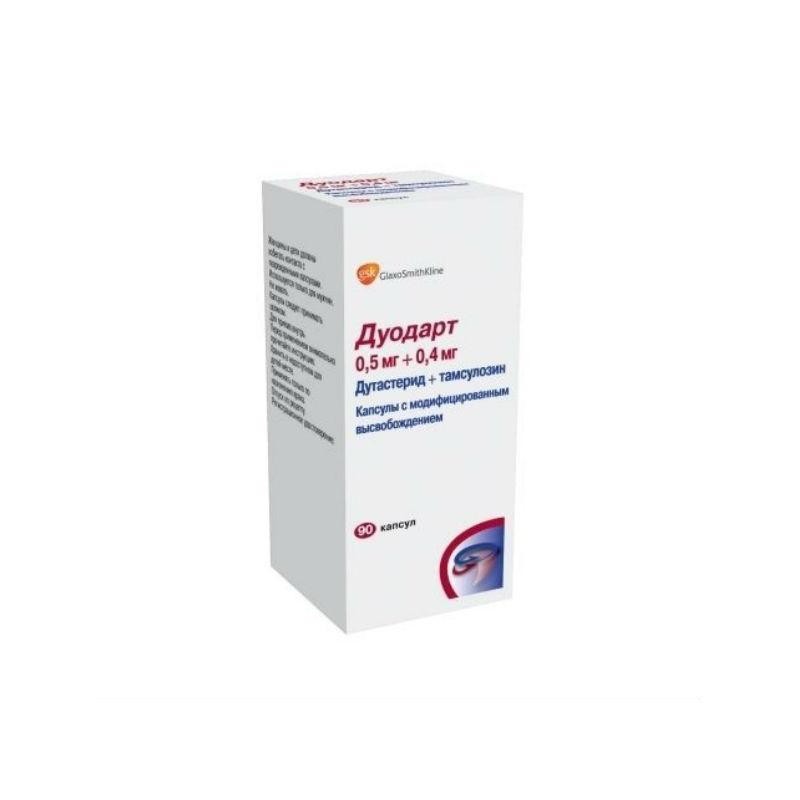



A drug for the treatment of benign prostatic hyperplasia. Alpha blockers.
After taking a single dose of dutasteride, the maximum concentration of the drug in serum is reached within 1-3 hours.
Absolute bioavailability is about 60% relative to a 2-hour intravenous infusion. Bioavailability of dutasteride does not depend on food intake.
Tamsulosin hydrochloride is well absorbed in the intestine and has almost 100% bioavailability. Tamsulosin hydrochloride is characterized by linear kinetics, both in single and multiple dosage regimens. With a single dosing regimen, the equilibrium concentration of tamsulosin hydrochloride is reached by the 5th day. The absorption of tamsulosin hydrochloride slows down after a meal. The same level of absorption can be achieved if the patient takes tamsulosin hydrochloride daily, 30 minutes after the same meal.
- treatment and prevention of progression of benign prostatic hyperplasia (reducing its size, reducing symptoms of the disease, improving urination, reducing the risk of acute urinary retention and the need for surgical treatment)
Dutasteride 0.5 mg and tamsulosin hydrochloride 0.4 mg are contained in one capsule.
No customer reviews for the moment.
Tulosin is taken orally after eating. 400 mcg (1 capsule) per day. Capsules are taken after the first meal, drinking plenty of water. The capsule should not be crushed and chewed.
The most common side effects (1–10%) - dizziness, drowsiness or insomnia.
Rare (0.1–1%) - headache, reduced visual acuity, rhinitis, nausea, vomiting, diarrhea or constipation, retrograde ejaculation, asthenia, decreased libido, back pain.
Extremely rare (0.01–0.1%) - orthostatic hypotension, tachycardia, increased heartbeat, chest pain, fainting, hypersensitivity reactions (skin rash, itching, urticaria, angioedema).
Hypersensitivity to tamsulosin hydrochloride or any other component of the drug Tulosin.
Carefully: chronic renal failure (a decrease in Cl creatinine below 10 ml / min); arterial hypotension (including orthostatic); severe liver failure.
The simultaneous use of cimetidine increases the level of tamsulosin in the blood plasma; Furosemide reduces its plasma levels. However, in both cases, these levels remain within therapeutically active levels, and the dosage should not be changed.
Diclofenac and indirect anticoagulants slightly increase the rate of elimination of tamsulosin.
The simultaneous use of tamsulosin with other α1-adrenergic blockers and other drugs that reduce blood pressure, can lead to a pronounced increase in the hypotensive effect.
No interaction was detected with simultaneous use of tamsulosin with atenolol, enalapril, nifedipine or theophylline.
Plasma tamsulosin concentration did not change in the presence of diazepam, trichloromethiazide, amitriptyline, diclofenac, glibenclamide, simvastatin or warfarin.
Tamsulosin also did not change the concentration of diazepam, propranolol, trichloromethiazide and chlormadinone.
Tamsulosin should be used with caution in patients with a predisposition to orthostatic hypotension, because, like in the case of taking other alpha1- blockers in some patients during the course of treatment can decrease blood pressure, which sometimes can lead to fainting. When the first signs of orthostatic hypotension (dizziness or weakness) appear, the patient should be seated or laid before the symptoms disappear.
Before starting drug therapy, the patient should be examined in order to exclude the presence of other diseases that can cause the same symptoms as BPH. Before treatment, and regularly during therapy, a digital rectal examination should be performed and, if required, a prostate-specific antigen (PSA) determination.
In patients with severe renal insufficiency (Cl creatinine less than 10 ml / min), the drug should be used with caution, because this group of patients has not been investigated.
Influence on the ability to drive a car or perform work that requires increased speed of physical and mental reactions. During the period of treatment, care must be taken when driving vehicles and engaging in other potentially hazardous activities that require increased concentration and psychomotor speed.
Symptoms: theoretically, the occurrence of acute hypotension.
Treatment: The patient should be placed in order to restore blood pressure and normalize heart rate. Cardiotropic therapy is performed. Renal function and general maintenance therapy should be monitored.